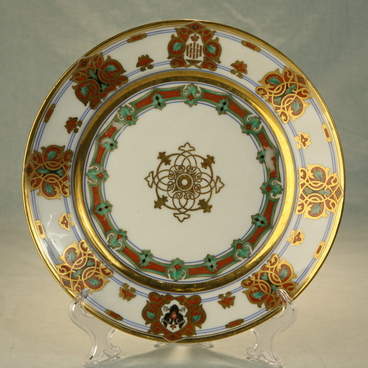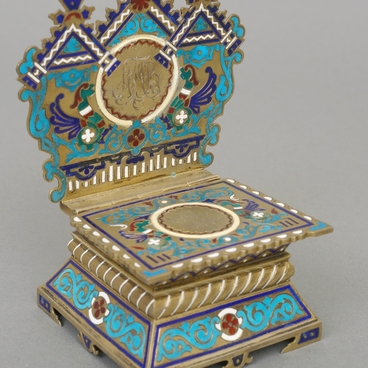A bronze clock is displayed in the central showcase. In the 19th century, mantel and table clocks were popular interior decoration. Such things, as a rule, were used to decorate living rooms, dining rooms, men’s home offices.
The décor of the watch case corresponded to the stylistic tendencies of the era. They were made of wood, bronze, marble, ceramics, adorned with elements of carving, inlay, enamel or even sculptural compositions. Table and mantel clocks were often chosen as expensive anniversary gifts.
Already in the first half of the 19th century, Russian crafts casting of bronze was distinguished by the richness of decorative finishes. The pomp and elegance, the excellent quality of casting, chasing and engraving allowed the works of Russian masters to compete with European bronze. In addition, a lot of masters from Western Europe, such as from France, worked in Russia, who knew all the technical innovations of the French school of artistic bronze very well.
The uniqueness of the watches presented in the exposition is not only in the fact that they belong to the group of “sketch” art items, that is, items made according to sketches of professional artists, architects, sculptors, but also in the fact that they bear the stamp of the manufacturer — the famous factory of artistic bronze by Alexander Sokolov. For interior items made of bronze, the presence of a stamp is something few and far between.
Alexander Sokolov was the owner of a lamp and bronze foundry well-known in Russia. It specialized in the production of church utensils, lighting fixtures in the “Russian style”, cabinet bronze, mantel clock cases, candlesticks and so on. The products of Alexander Sokolov’s factory were of high quality and were in demand.
The décor of the watch case corresponded to the stylistic tendencies of the era. They were made of wood, bronze, marble, ceramics, adorned with elements of carving, inlay, enamel or even sculptural compositions. Table and mantel clocks were often chosen as expensive anniversary gifts.
Already in the first half of the 19th century, Russian crafts casting of bronze was distinguished by the richness of decorative finishes. The pomp and elegance, the excellent quality of casting, chasing and engraving allowed the works of Russian masters to compete with European bronze. In addition, a lot of masters from Western Europe, such as from France, worked in Russia, who knew all the technical innovations of the French school of artistic bronze very well.
The uniqueness of the watches presented in the exposition is not only in the fact that they belong to the group of “sketch” art items, that is, items made according to sketches of professional artists, architects, sculptors, but also in the fact that they bear the stamp of the manufacturer — the famous factory of artistic bronze by Alexander Sokolov. For interior items made of bronze, the presence of a stamp is something few and far between.
Alexander Sokolov was the owner of a lamp and bronze foundry well-known in Russia. It specialized in the production of church utensils, lighting fixtures in the “Russian style”, cabinet bronze, mantel clock cases, candlesticks and so on. The products of Alexander Sokolov’s factory were of high quality and were in demand.
The success of the enterprise was due, among other things, to the fact that well-known professional sculptors and artists were involved in cooperation, including Nikolai Liberich, Eugene Lanceray, Alexander Opekushin.
In 1873, Sokolov received the title of the imperial court’s supplier. After receiving the status and participating in exhibitions, the imprint of a two-headed eagle and a schematic image of the obverse and reverse of the exhibition medal were also added to the factory hallmark on products.
In 1873, Sokolov received the title of the imperial court’s supplier. After receiving the status and participating in exhibitions, the imprint of a two-headed eagle and a schematic image of the obverse and reverse of the exhibition medal were also added to the factory hallmark on products.



